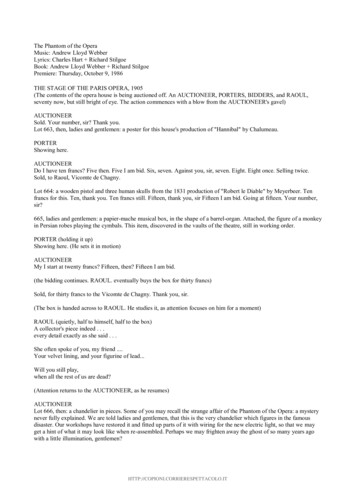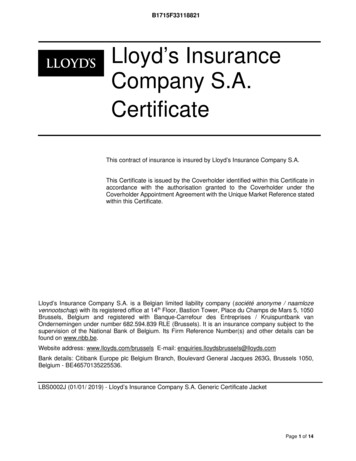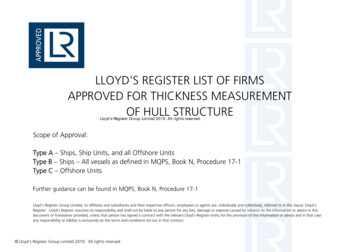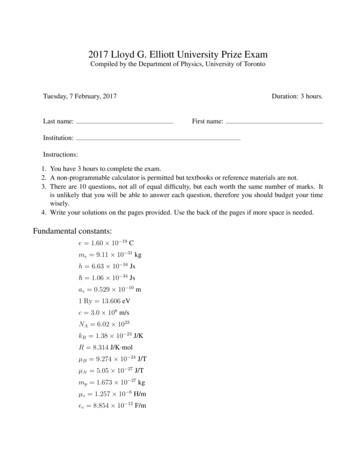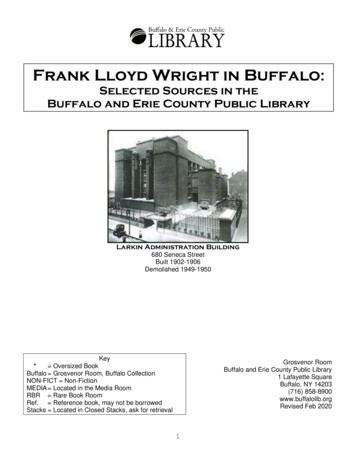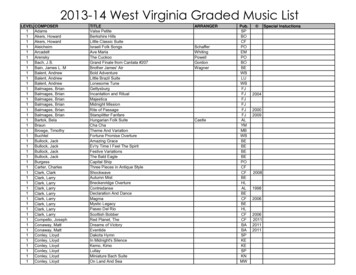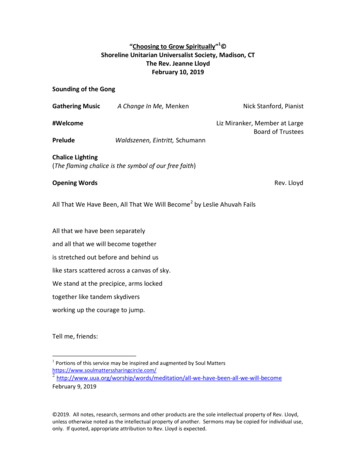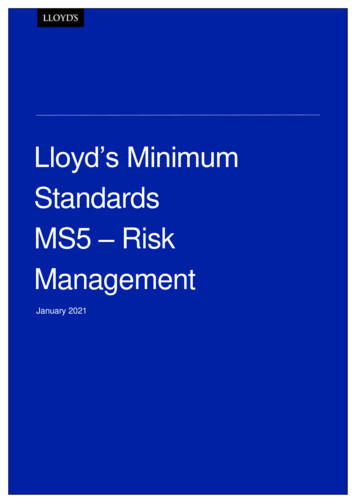
Transcription
Lloyd’s MinimumStandardsMS5 – RiskManagementJanuary 2021
2ContentsMS5 – Risk Management3Minimum Standards and Requirements3Guidance3Definitions3Section 1: Risk Management SystemRM 1.1 Effective risk management system44Section 2: Risk GovernanceRM 2.1 Risk Management StrategyRM 2.2 Decision MakingRM 2.3 Risk Policies66810Section 3: Risk ProcessesRM 3.1 Risk Identification & AssessmentRM 3.2 Risk Monitoring & Reporting121216SECTION 4: OWN RISK & SOLVENCY ASSESSMENTRM 4.1 ORSA ScopeRM 4.2 ORSA PolicyRM 4.3 ORSA ProcessRM 4.4 ORSA Report1818192021Appendix – Links23MS5 – Risk Management
3MS5 – Risk ManagementMinimum Standards and RequirementsThese are statements of business conduct required by Lloyd’s. The Minimum Standards are established under relevantLloyd’s Byelaws relating to business conduct. All managing agents are required to meet the Minimum Standards. TheRequirements represent the minimum level of performance required of any organisation within the Lloyd’s market tomeet the Minimum Standards.Within this document the standards and supporting requirements (the “must dos” to meet the standard) are set out in theblue box at the beginning of each section. The remainder of each section consists of guidance which explains thestandards and requirements in more detail and gives examples of approaches that managing agents may adopt to meetthem.GuidanceThis guidance provides a more detailed explanation of the general level of performance expected. They are a startingpoint against which each managing agent can compare its current practices to assist in understanding relative levels ofperformance. This guidance is intended to provide reassurance to managing agents as to approaches which wouldcertainly meet the Principles and Minimum Standards and comply with the Requirements. However, it is appreciated thatthere are other options which could deliver performance at or above the minimum level and it is fully acceptable formanaging agents to adopt alternative procedures as long as they can demonstrate the Requirements to meet theMinimum Standards.DefinitionsECA: Economic Capital AssessmentEIOPA: The European Insurance and Occupational Pensions AuthorityORSA: Own Risk and Solvency AssessmentSCR: Solvency Capital Requirements. [Where the risk management standards and guidance refer to the SCR this coversboth the 1 year and ultimate numbers generated by the internal model]The Board: Where reference is made to the Board in the standards, managing agents should read this as Board orappropriately authorised committee. In line with this, each agent should consider the matters reserved for the Boardunder the Governance Standard in order to evidence appropriate full Board discussion and challenge on the materialsitems.MS5 – Risk Management
4Section 1: Risk Management SystemRM 1.1 Effective risk management systemManaging agents shall have in place an effective risk management system.The risk management system shall: comprise strategies, processes and reporting procedures necessary to identify, measure, monitor, manage andreport on a continuous basis the risks, at an individual and at an aggregated level, to which they are or could beexposed, and their interdependencies; be well integrated into the organisational structure and in the decision making processes of the managing agent;and cover the risks to be included in the calculation of the SCR as well as the risks that are not or not fully included inthe SCR calculation.Risk management is a continuous process that is used in the implementation of the business strategy and allows for anappropriate understanding of the nature and significance of the risks to which the business is exposed, including itssensitivity to those risks and its ability to mitigate them.Managing agents should ensure that there is a coordinated and integrated approach to risk management and a commonrisk language that is understood across the business.The Board is ultimately responsible for ensuring the effectiveness of the risk management system, setting risk appetiteand overall risk tolerance limits as well as approving the main risk management strategies and policies. Whilst riskmanagement is the responsibility of the Board as a whole, Lloyd’s requires that the risk management function shouldreport to a nominated director (see GOV 6.1). The current EIOPA guidelines and explanatory notes on the system ofgovernance also propose that at least one Board member is designated to oversee the risk management system on theBoard’s behalf. The detailed requirements with regard to the risk management function are covered in Lloyd’sgovernance standards (GOV 6.1 & 6.2).Elements of the risk management systemThe standard sets out the features of an effective risk management system at a high level. Further requirements andguidance relating to these are covered within other sections of the standards and guidance as set out below:SubjectReference in Standards/GuidanceRisk strategyRM 2.1Risk governance structureRM 2.1Decision making processesRM 2.2Risk identification and assessmentRM 3.1Risk reportingRM 3.2MS5 – Risk Management
5Risk coverageThe risk management system must incorporate all material risks, both those that are included in the calculation of theSCR1 and those that may not be, such as reputational and strategic risk. Consideration should also be given to emergingrisks (see RM 3.1 for further detail on processes in relation to emerging risks).For capital purposes the focus is the 1:200 point of the distribution, but this should not be the sole focus of the riskmanagement system and consideration will need to be given to other points on the distribution as appropriate, forexample, comparison with expected or planned performance.MS5 – Risk Management
6Section 2: Risk GovernanceRM 2.1 Risk Management StrategyThe risk management system shall include a clearly defined risk management strategy which is consistent with themanaging agent's overall business strategy.Managing agents shall ensure that the approach to risk management is communicated throughout the organisation andsupported by explicit ownership of the risks and a clear allocation of responsibilities for their day to day management.The risk management strategy shall be documented, including the managing agent's: objectives; key risk management principles; risk appetite and approved risk tolerance limits; risk management approaches and processes; and assignment of risk management responsibilities across all the managing agent's activities.Business strategy can be defined as the high-level plans that are developed by a managing agent and are furtherspecified via policies and business plans to ensure implementation in day-to-day business.The risk management strategy should define and communicate the managing agent’s approach to managing risk bydetailing the framework, tools and governance in place to deliver the defined strategy. It should illustrate how thisapproach is consistent with the overall business strategy. The top level business and risk strategy should be owned anddirected by the Board.Lloyd’s does not prescribe the exact structure and content for managing agents’ risk documentation. However, it isimportant for managing agents to ensure that they have a comprehensive suite of risk management documentation thatcovers all the areas expected.Organisational structure and risk responsibilitiesA good organisational structure supports the effective management of risk. The structure should be appropriate to themanaging agent but typically would provide for three levels of governance with respect to risk: direct responsibility for the management and control of risk (i.e. staff and management working within ormanaging operational business units together with the Board);co-ordination, facilitation and oversight of the effectiveness and integrity of the risk management framework(e.g. the risk committee and risk management function); andprovision of independent assurance and challenge across all business functions in respect of the integrity andeffectiveness of the risk management framework (i.e. internal and external audit).Such a structure is commonly referred to as the ‘three lines of defence’ model.An effective structure would typically have clear accountability and expectations which will help achieve businessobjectives and ensure decisions are co-ordinated and consistent with stated risk appetite and policy. Carefulconsideration should be given to the allocation and communication of roles, responsibilities and accountabilities acrossthe business, and the setting of rules and processes for risk based decision making and reporting to ensure that theseare appropriate.MS5 – Risk Management
7It is important that all relevant parties understand their roles, responsibilities and accountabilities; including what isexpected of them and their authority for decision making and reporting (i.e. each relevant individual is able to explain whothey are accountable to, in what manner and how relevant risk appetites and policies apply to their role). There shouldalso be a clear understanding of the relationships and associated tasks between key business and functional areas toensure that all relevant parties are able to share relevant information and take account of all relevant and significantfactors in order to make informed decisions.Managing agents should ensure that they provide appropriate risk management tools, that are easily accessible, tosupport their processes and staff. Appropriate training and development should also be provided, for all staff,surrounding all aspects of the managing agent’s approach to risk management.The risk management framework should be underpinned by a commonly agreed and understood terminology andlanguage for risk that complement the managing agent’s culture and business practice, used by, and readily available to,all staff.The organisational structure should facilitate appropriate risk information flows around the business on a timely basis,and there should be processes in place to escalate risk issues. To be effective, escalation processes would typically beaccessible to all and have clearly laid-out procedures, trigger points and escalation points. It is important to ensure thatthe confidentiality, integrity and availability of information is maintained, particularly relating to those processes critical tothe success of the businessThere should be unambiguous ownership of every aspect of the risk management process across the business.Ownership involves a range of responsibilities and could be defined using set roles such as: risk owner - has responsibility for managing and co-ordinating all aspects of the risk, ensuring that relevantinformation is available and assessed, and that relevant individuals are aware of the risk and involved indecision-making; andcontrol/action plan owner - responsible for the management and execution of controls/action plans surroundinga specific risk.Managing agents should also refer to GOV 2.1 & 2.2 which set out more general requirements with regard toorganisational structure and segregation of duties.Risk management strategyThe risk management strategy should be documented, with further detail of the day to day implementation of the strategyset out in supporting documentation, typically in specific risk policies. The following sections set out more detail of areasthat should be covered in the risk strategy and other supporting documentation.ObjectivesThe approach to risk management should be consistent with the overall business strategy and therefore the risk strategyobjectives should be derived from the actions in place to deliver the overall business plans. Typically the risk strategyobjectives would be expressed at a relatively high level setting out broadly how the risk strategy is consistent with thehigh level business strategy.Key risk management principlesThe risk management principles should underpin the approach to risk management and guide the maintenance anddevelopment of the risk management framework. Examples include statements about the approach to risk governance,risk ownership and the risk culture.MS5 – Risk Management
8Risk appetite and approved risk tolerance limitsWhilst Solvency II refers to both risk appetite and risk tolerances, these terms have not been explicitly defined withincurrent Solvency II requirements or guidance. The following section sets out general guidance in relation to risk appetiteand risk tolerances for agents to consider. Lloyd’s acknowledges that managing agents may have their own definitionsfor these terms, which do not align to the descriptions below. Some agents also use the term ‘risk capacity’ which is seenas a function of financial strength and risk management capability.The high level risk management strategy documentation should set out the overall approach, with more detail in asupporting risk appetite framework or similar documentation. This section sets out areas for consideration in relation torisk appetite and provides some guidance on how risk appetite and tolerances could be defined.Risk appetite can be defined as the articulation of the managing agent’s willingness to take on risk, and should focus, ata minimum, on the most material risks of the business. Managing agents should define and describe their risk appetiteand overall risk limits to manage significant risks from all sources.Risk appetite addresses the attitude of the Board towards the most significant risks faced by the business. Board levelrisk appetite metrics should be consistent with strategic high level objectives and also be sufficiently detailed to beapplied practically. They may include quantitative assessments in terms of risk and capital, as well as qualitativestatements. The metrics should provide the Board with a snapshot of the risk profile of the business against which theBoard can judge if risk taking is within acceptable boundaries.Overall risk tolerance limits can be defined as the restrictions the managing agent imposes on itself when taking risks.This may include detailed limits and triggers supported by monitoring processes and should guide day to day decisionmaking in line with the overall risk appetite metricsEach risk category needs to be addressed by the combination of risk appetite and tolerances, although there may not bean explicit risk appetite statement for every category. For example, group risk may be considered as part of operationalrisk with appropriate tolerances set around it, rather than having a separate group risk appetite statement.It is important that risk appetites and tolerances are clearly communicated to all relevant managers and staff at all levelsand cascaded as appropriate throughout the managing agent. They should guide risk acceptance and decision-makingthroughout the business.Risk management approaches and processesThe risk management strategy should provide an overview of the risk framework and the approaches and processes inplace to manage risk. There should also be supporting documentation such as risk policies and procedure documentswhich set out more detail of the risk processes in place. More detailed guidance on risk policies and risk processes is setout in sections 2 and 3 of the risk management standards.RM 2.2 Decision MakingManaging agents shall have a clearly defined procedure on the decision-making process within the framework of therisk management system.Managing agents shall ensure that: risk and risk management issues are addressed by the Board and appropriate committee(s);the identification and assessment of risk and control prompts action where necessary; andthe persons who effectively run the business or have other key functions take into account the informationreported as part of the risk management system in their decision making process.MS5 – Risk Management
9Managing agents should ensure that there is clarity over the risk decision making process, in particular which bodies orindividuals have decision making authority.Board and committee responsibilitiesThe operation of the risk governance structure should provide adequate oversight and challenge to ensure that risks arebeing appropriately managed in line with the agreed risk appetite. This requires that proper consideration is given to riskissues at Board level as well as appropriate reporting through the committee structure. Managing agents are responsiblefor determining the most appropriate risk governance structure for their business, taking account of the need to ensurethat any forum they have in place has members with relevant and appropriate expertise and experience, appropriateterms of reference and the authority to act on relevant issues. It is usual practice to establish a risk committee withoversight of the entire risk management framework to ensure that risk matters are given sufficient attention and focus.Whatever risk governance structure is adopted, care should be taken to ensure that the objectives of risk committees areclear, in particular as to whether their role is principally risk oversight or risk management. A risk oversight committeewould typically have a majority non-executive membership, whereas a risk management committee would include moreexecutive members with direct responsibility for managing the risks in the business. Well defined committee terms ofreference will help to ensure appropriate membership and reporting, and ultimately the overall effectiveness of thecommittee.Risk responsesThe identification and assessment of risk and control, which is described in more detail in RM 3.1, should promptappropriate action where necessary. There are a number of ways in which managing agents may respond to risk,including: transfer part of the risk elsewhere; for example by buying insurance or reinsurance;treat or mitigate the risk; i.e. reduce the likelihood and/or impact of it;accept or tolerate the current level of risk, where risk is approaching or already at risk tolerance limits. This maybe appropriate where mitigating the current level of risk is disproportionate to the benefits to be gained by doingso;eliminate or terminate; for example by exiting a class of business altogether; andamending risk appetite levels or tolerating the breach for a short time (in which case the rationale should bedocumented).When determining the appropriateness of risk responses the following could be considered: the feasibility and relative costs (direct, indirect and opportunity) and benefits of alternative risk responseoptions, the cost to design and implement a new control, and the on-going cost of operating the control;the qualitative aspects of the risk, such as the impact on reputational risk;the need to ensure that responses are based on a comprehensive understanding of risk and its components,particularly the causes of risk, to ensure that they are addressed;how risk events and their controls interact with one another. In determining the most appropriate response aportfolio view of risk and control can enable management to determine whether the overall level of risk in thebusiness is commensurate with its risk appetite; andwhether risks that cannot be controlled to within acceptable levels should be avoided, or contingency plansdeveloped.Action plans are typically developed and implemented to address unacceptable levels of risk and/or remediation ofcontrol weaknesses.Managing agents should consider how the assurance processes can ensure the effective operation of controls and theimplementation of action plans.MS5 – Risk Management
10Risk informationManaging agents should ensure that there is effective reporting of key risk information to the relevant governance forumsto ensure that those involved have all the information that they need to take into account in the decision making process.Section RM 3.2 below sets out more detailed standards and guidance in relation to risk reporting.RM 2.3 Risk PoliciesManaging agents shall have in place written risk management policies.The risk management policies shall cover the following areas: underwriting and reserving;asset-liability management;investment, in particular derivatives and similar commitments;liquidity and concentration risk management;operational risk management; andreinsurance and other risk mitigation techniques.Managing agents shall ensure that the risk management policies: meet the requirements set out in Lloyd's Governance Standard GOV 2.4;define and categorise the material risks by type to which the business is exposed;define the approved risk tolerance limits for each type of risk;implement the managing agent’s risk strategy;facilitate control mechanisms; andtake into account the nature, scope and time horizon of the business and the associated risks.Whilst this standard refers to separate policies for each area, this does not necessarily mean that separate documentsare needed for each. It would be acceptable to have one document covering all risk types or to have separate policies foreach risk type. There may also be separate supporting documentation, for example setting out details of the current riskappetite and tolerances or stress and scenario testing framework. Whichever approach is adopted, managing agentsshould ensure that their documentation covers the areas set out in the standard.The standard requires managing agents to define and categorise their material risks by type. Here, the term ‘risk type’can be used interchangeably with ‘risk category’ (see section 3.1 below for further guidance on risk categories).Risk management policyThe risk management policy is one of the governance policies required under Lloyd’s Governance standards and generalrequirements and guidance is set out in GOV 2.4.The risk management policy would typically: define the risk categories and the methods to measure the risks;cover all material risks, including emerging risks, quantifiable or non-quantifiable and reputational and strategicrisks where relevant;outline how the managing agent manages each relevant category and area of risk;consider potential accumulation and interactions of risk;MS5 – Risk Management
11 specify risk tolerance limits within all relevant risk categories in line with the managing agent’s overall riskappetite; andset out the process and frequency of regular stress and scenario tests, and describe the situations that wouldwarrant special stress and scenario tests.Managing agents need to ensure that their documentation covers the areas set out in Solvency II, level 2, Article 260paragraphs 1(a) to (g) with regard to the following: underwriting and reserving risk;asset-liability management;investment risk;liquidity risk;concentration risk (i.e. aggregation of risk exposures within and between risk categories);operational risk; andreinsurance and other mitigation techniques.MS5 – Risk Management
12Section 3: Risk ProcessesRM 3.1 Risk Identification & AssessmentThe risk management system shall include processes by which a managing agent can identify, assess and mitigate thesignificant risks to the achievement of its business objectives.Managing agents shall ensure that: their processes are proportionate to the nature, scale and complexity of the risks inherent in the business;they consider the risks to which they are or could be exposed in the short and long term;formal risk identification is undertaken at least annually, and updated regularly;risk is assessed using appropriate qualitative and/or quantitative techniques, which include consideration of riskaggregations and correlations;there are internal controls in place, designed to manage risks to acceptable levels and the effectiveness ofcontrols is regularly considered in managing and balancing risk and appetite;details of all significant risks and controls are documented, e.g. in a risk register;they include the performance of stress tests and scenario analysis, including reverse stress tests, with regardto all relevant risks faced by the business in their risk management system;their processes do not place undue reliance on third party information and that, where relevant, they take stepsto verify the appropriateness of any such information as part of their risk management; andthey have a process to identify, assess and manage emerging risks.Managing agents should ensure that they adopt processes for risk identification and assessment that are appropriategiven the nature, scale and complexity of risks inherent in the business. It is important to ensure that the appropriateindividuals from across the business are involved and that they understand the relevant aspects. The identification andassessment of risks should be clearly documented.Risk identificationRisk identification is a key component of a robust risk management framework. As an initial step in this processmanaging agents should ensure that they have a clear understanding of their risk universe. This can be defined asdocumenting the various types of risk the business may face.An effective risk identification process would typically: identify the significant risks to the achievement of the business objectives;identify all types of risk, associated major components and controls currently in place, from all sources, acrossthe entire scope of the managing agent’s activities;identify risks around opportunities as well as threats, to increase the managing agent’s chance of maximisingthe benefit of those opportunities when they arise;ensure that the managing agent is aware of its major risks at any point in time, and include elements to updateits understanding of risk on an ongoing basis, such as key indicators;focus on the root causes and influencing factors of risk, both internal and external, as well as its effects andoutcomes: financial, reputational and other; andlook forward, as well as drawing on past experience, by including elements such as horizon scanning.MS5 – Risk Management
13Risk categories aid effective, systematic and comprehensive risk identification, forming the basis for a more detailedidentification process to ascertain individual risks and their components. Managing agents should consider carefully therisk categories that they adopt and there should be clarity over how these map to Solvency II risk categories.Managing agents may wish to employ a combination of “bottom up” (typically starting with data analysis, building up intoan aggregate view) and “top down” (e.g. starting with the consideration of influencing factors or risk groups) toolsaccording to the size and complexity of the business.Risk assessmentRisk assessment enables a greater understanding of risk, and is vital to the process of making risk-based decisions, byproviding: comparison of risks against each other, thereby helping to prioritise risks in terms of the focus and attention thatshould be given to individual risks;comparison against appetite, prompting remedial action and providing assurance towards the “in control” statusof the organization;cost versus benefit analysis of risk taking activities and alternative control options; andvaluable input into the capital assessment process.An effective assessment of risk would typically be reviewed regularly to ensure it stays relevant and appropriate to thenature and level of risk within the business. The frequency of review should reflect the risk profile of the business, andmight typically be quarterly or six-monthly. Managing agents should also look to ensure that their risk assessmentsidentify potential aggregations of risk and risks that interact or correlate either positively or negatively across thebusiness.It is up to managing agents to decide on the most appropriate risk assessment process for the risks that they face, whichmay not necessarily be the same for all risk categories. For example, the processes followed for operational risk andinsurance risk are likely to be different, given the nature of the information available to support the assessment.Qualitative and quantitative assessmentManaging agents should ensure that they use an appropriate assessment method which might be qualitative orquantitative, or a combination or both. The appropriate method will depend on a number of factors, including the natureof the risk and the managing agent’s risk policy. Whatever methods are chosen, the managing agent should be able todemonstrate the effectiveness and appropriateness of its assessment criteria and techniques.Qualitative methods are often used to facilitate risk assessment and encourage discussion e.g. in risk workshops. Theyare also used when there is insufficient data to perform more quantitative assessments or where more subjectivejudgement is needed. When using qualitative assessment methods it is important to be aware of the need to use the rightpeople, with the appropriate competence and experience.Where self- assessment methods are being used, there should be procedures to provide challenge and oversight toensure judgement is being consistently applied across the organisation. This is important as there can be a significantdiversity in judgmental perceptions of risk from person to person. Given the subjective nature of such assessments, keyindicators and loss analysis may be of benefit to corroborate or challenge them.Quantitative tools rely on the availability of a sufficient amount of reliable historical data. Where there is insufficientinternal data, the use of an external loss database may provide some benefit. Managing agents should however givecareful consideration as to whether that external data is appropriate to their risk profile, and relevant to the particularrisks being assessed. Furthermore, they should also take into account that they have relatively little control over thecompleteness and accuracy of information compiled in an external database.MS5 – Risk Management
14The use of internal databases should also be tre
MS5 - Risk Management Contents MS5 - Risk Management 3 Minimum Standards and Requirements 3 Guidance 3 Definitions 3 Section 1: Risk Management System 4 RM 1.1 Effective risk management system 4 Section 2: Risk Governance 6 RM 2.1 Risk Management Strategy 6 RM 2.2 Decision Making 8 RM 2.3 Risk Policies 10 Section 3: Risk Processes 12

